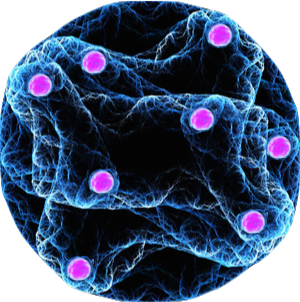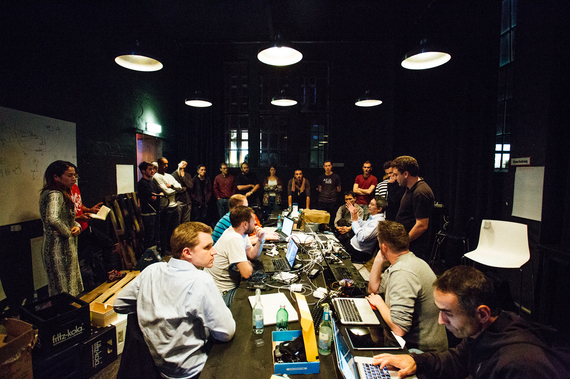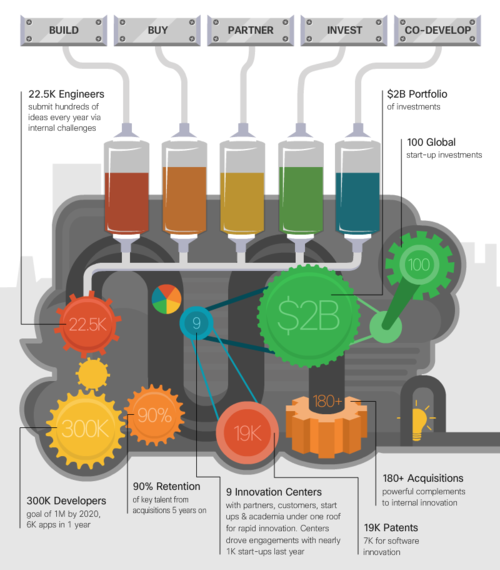Earlier last month, Cisco Systems was ranked 31st by the Boston Consulting Group's Top 50 Most Innovative Companies of 2015. Although it may not be a surprise to see Cisco on the list, it is rare to see how Cisco nurtures innovation.
Innovate verb in·no·vate \ˈi-nə-ˌvāt\
Innovation is strongly associated with gadgets and gizmos, but the term's origin is in the latin verb, innovare - to make change. Innovation requires human intervention to plan, build, and manage its chaotic forces. At Cisco, the innovation engine is driven by five pistons:
Within this innovation machine is a little known jewel called, Cisco Hyper-Innovation Living Labs (CHILL). True to its name, CHILL provokes disruption by emulsifying solutions from non-competing companies in various industries. This involves mustering senior executives from Fortune 500 companies at undisclosed locations around the globe for 48 hours.
The locations of these conclaves are trivial; it's the ideas and solutions, which are most intriguing. After several several attempts, I was fortunate to meet with the oracle of CHILL, Kate O'Keeffe.
The Alchemist
Kate is originally from Melbourne, Australia, and has traversed the globe to fulfill her Personal Legend. It would seem like an overnight success for anyone to go from the owner for a bridal shoe store in Australia to commandeer one of the largest tech companies in the world. However, her journey through the precarious forest of innovation can be characterized by one word - persistence.
One of Kate's initiatives was creating Cisco's Services Excellence Innovation Center (SEIC), which fosters ingenuity within Cisco. Instilling change within a Fortune 100 company is not easy, let alone a successful implementation. But her tenacity had achieved results: 1 in 40 internal ideas became fully implemented within the company, which was 3 times higher than the industry benchmark.
We met inside Building 10 at Cisco headquarters in San Jose. We are surrounded by toys - Legos, trains, 3D printed sculptures, and a curious dollar bill mounted on the wall. They are not presents for the twins Kate's expecting; it is for the engineers to build low fidelity solutions.
Innovation vs. Hyper-Innovation
Innovation at a large organization is traditionally nurtured and deployed internally. As a result, solutions are insular and focus on acute pain. Unfortunately, 70-90% of these projects fail. CHILL has a peculiar business model because it creates solutions for its partners with its partner's partners. 
The fundamental difference between innovation and hyper-innovation is the aggregation of multiple organizations, working together to alleviate chronic and systemic problems. Kate explains that every CHILL involves a multi party dialogue between 5-6 corporate partners. This cross pollination of ideas and resources lead to breakthroughs that would not normally occur in isolation.
Living Labs
Large corporations are notorious for being lumbering giants that are conservative in planning, slow to build, and hierarchal in management. CHILL disrupts this notion by giving teams autonomy and access to technical talent, strategic partners, and seed capital. All under one roof, within 48 hours.
A Living Lab occurs once a quarter. 12-16 weeks before a lab occurs, an anchor partner approaches CHILL with problems to solve. Based on the use cases, four to five partners are curated and invited to join the lab. These partners are selected based on mutually symbiotic traits. For example, Nike, Lowe's, and Costco wanted to create a frictionless shopping experience. Consequently, Visa was invited to provide domain expertise in payments. During this pre-lab stage, code libraries are built, letter of intents are forged, and teams are wrangled.
The actual lab is an intense 48 hours of co-creation with all participating partners present. The collective group of over a hundred individuals is then mixed into 4-6 teams. Each team includes a dozen Cisco engineers, business units, and most importantly, the end user. Together, they tussle over 8-12 rounds of customer feedback, distilling concepts with each iteration.
"Tailored short-term teams with radically diverse yet relevant skills help identify opportunity areas quickly."
- Harvard Business Review
CHILL is a bootcamp for innovation. The Minimum Viable Products (MVP) are raw prototypes born from sheer brute force. Kate emphasizes that the innovation process is rarely linear. Three of Five Teams have scrapped their MVP in favor of a new concept, hours before presenting their efforts to senior executives. This places incredible pressure on the engineers tasked with spawning butterflies from caterpillars within the final 24 hours.
The ownership of Intellectual Property (IP) can also be ambiguous when it is co-created by multiple companies. CHILL resolves this hurdle by having all parties agreeing to equally split the IP rights created in the lab. Should a spin off company occur, the IP is likely transferred to the company, in exchange for shares. This asset transfer model has a similar structure with University Technology Transfer Offices.
Bippity Boppity Boo
Within 48 hours, projects are vetted by a senior executive investment team. In this Shark Tank setting, projects are evaluated and investment secured on the spot based on the value at stake and the presence of a joint investor. Investments are accelerator sized ($10K - $200K per project) with additional funding available in tranches. At the time of publication, only strategic partners are involved in financing CHILL's spin offs. However, investment from private venture capital firms are in the works for 2016.
After the circus rolls through, the real work begins. Funded teams are expected to develop consumer grade products within 60 days of the lab. Since the inception of CHILL, a third to two thirds of projects have been progressed to further stages. Kate explains that success is measured by growth, both in terms of operational excellence and on the balance sheet.
Kissing Frogs
Innovators understand that commercial success is statistically improbable. The motivation is in the opportunity to develop a breakthrough that becomes a sustainable and scalable competitive advantage. It becomes less about the number of frogs kissed, than it is about the number of princes that appear.
The most notable aspect of CHILL is the manner of how innovation is created and deployed. The creative process nurtures agile development and operational freedom. Although CHILL is still in its infancy, there are early indications of a healthy harvest in a matter of months.



